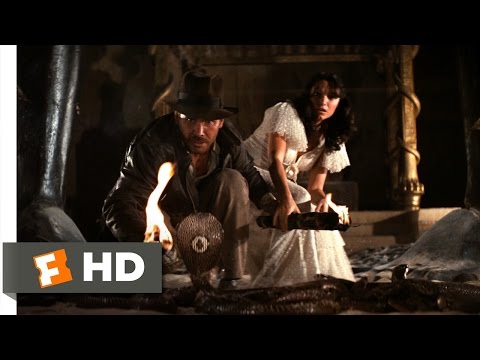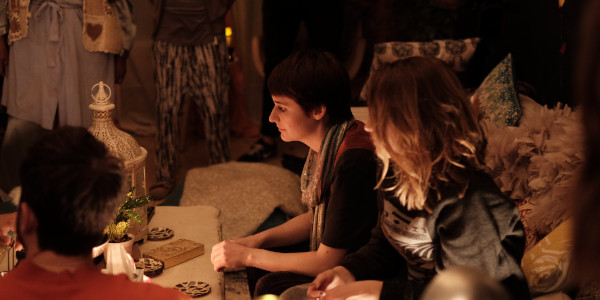17 Blocks

“17 Blocks,” a documentary about 20 years in the life of a Washington, D.C. family, is so emotionally punishing that you might have to steel yourself at a couple of points to get through the roughest patches. This is by no means a knock against the quality of the filmmaking or the unvarnished truth of the events it depicts, but a warning that the household shown here suffers the torments of Job (whose name is invoked by a preacher presiding over a funeral later in the story) and that the light at the end of the tunnel is a long time coming, and glimpsed only briefly before the end credits.
Taking us from the end of the millennium through late 2018, “17 Blocks” refers to the distance between the home of the film’s main family, the Sanfords, and the U.S. Capitol. Much has been made in journalism, history, and American cinema/television of the proximity between the seat of American federal power and the mostly black, working-class-to-poor neighborhoods that have predominated in the city of Washington, D.C. (at least until recently, when gentrification started ramping up the white population and pricing Black people out—something that would happen to the Sanfords, too). But it’s hard to think of another nonfiction feature that depicts the contrasts and ironies as plainly as this one. “17 Blocks” focuses on a mother, her children, and her grandchildren. All are affected, directly or indirectly, by drug abuse (within the family and in the community at large) as well as by the gun violence that is never far from areas (of any demographic) where street-level dealing occurs.
The story begins in the mid-aughts, with the family matriarch, Cheryl Sanford, visiting the house that belonged to her father, and where she raised three children: her eldest Emmanuel, her middle child “Smurf,” and their sister younger sister Denise. It’s immediately apparent from Cheryl’s speech patterns, body language, and facial discolorations that she’s a drug addict (we later learn that her drug of choice is cocaine, though it’s not the only substance she abuses), and the earliest flashbacks (circa 1999) reveal that she’s been dealing with addiction her entire adult life. She blames herself for Smurf’s drug use as well as his decision to drop out of high school at 15 and start dealing. There’s a lot of self-blame and self-flagellation in this story, all of which was accumulated sincerely and in great distress but none of which ultimately means much in the face of the addiction and its collateral damage continuing over the course of decades.
The documentary’s introductory scene and subsequent, flash-forward-type allusions prepare you for the fact that something horrible is going to happen to the Sanfords. When it does happen, it’s even worse than what you anticipated. A brief sequence of a family member cleaning up bloodstains—literally a mess they’ve been stuck with—is one of the most upsetting examples of life handing somebody a metaphor that you’ll ever see.
That’s all storytelling, of course; a magic trick done with images and sound. We know that in real life, people have addiction problems; that it continues over the generations, addiction being a genetic predisposition, not just an indicator of moral weakness or bad upbringing; that sometimes tragedy visits people’s homes randomly, shockingly, without warning; and that just because all these bad things happened to one family, it doesn’t mean it was all somehow inescapable or “foretold,” much less that the family “deserved” it or “reaped what they sowed,” or that survivors can’t will a new path if they push hard enough and catch a few breaks (which does happen for the Sanfords eventually, thank goodness, although it’s a long road).
“17 Blocks” was directed, produced, and overseen by documentarian and writer Davy Rothbart, with a mighty assist from editor/producer Jennifer Tiexiera (whose “written by” credit, unusual for a nonfiction project, suggests that she took a strong hand in shaping a coherent narrative from what Rothbart says was over 1,000 hours of video). It’s impossible to oversell the mesmerizing nature of the images themselves. They’re consistently moving without (usually) striving for prettiness. The change in the images’ shape and resolution itself helps organically suggest the passage (or slippage) of time from one era to the next, even when we aren’t seeing obvious indicators of maturation onscreen (such as changes in seasons, fashions, hairstyles, or music).
According to Rothbart, he met Emanuel and Smurf Sanford in 1999 during a pickup basketball game a few blocks from their house and started hanging out at their house. After a certain point he started filming them and leaving his camera at their house on weekends. Pretty soon the Sanford family was using it to document their own lives. The footage that’s been culled from that early, more-or-less amateur era is astonishing in its honesty and frankness, with the family (Emmanuel in particular) treating the camcorder as a journaling notebook in the guise of a machine: a thing that could be switched on easily to record any moment, fleeting or momentous.
“17 Blocks” probably doesn’t push hard enough against reactionary, Puritan, possibly racist readings of the Sanford family’s misery as it should have, in order to guard it more righteously against bad faith interpretations—including Cheryl’s own. She often seems to blame every awful thing that happens to her family on her addiction, and it isn’t until very late in the film that we learn that her addiction didn’t manifest itself out of the clear blue: it seems very obviously a form of self-medication in reaction to having been gang-raped by a group of young men when she was barely adolescent. And one of the movie’s virtues, its compactness, is often a liability. It divorces the family’s suffering from social and political context. Most of the time you just have to infer the wider effects of racism, de facto segregation, financial “redlining,” and anonymous military-style police occupations of Black neighborhoods (rumbling helicopters and flashing red-and-blue lights are a constant) on families like the Sanfords. Steve James and Stanley Nelson, to name just two filmmakers who often tell stories about Black families, manage to weave all this into stories that are just as focused on feelings, so it’s not as if it’s impossible to pull off.
On the whole, though, this is an engrossing and frequently extraordinary feature. At times it suggests a nonfiction, Black, inner-city answer to a sprawling, predominantly white, suburban feature like Richard Linklater’s “Boyhood” or Terrence Malick’s “The Tree of Life,” where (via every means at their disposal) the filmmakers give you a sense not just of characters flowing through a river of time but families struggling to make sense of changes happening around them: in communities; in households; on their own faces when they look into mirrors and at photographs.
Many affecting motifs have to do with the repetition of actions or conversations at different points in the family’s existence: a mother or one of her children commenting on her appearance in pictures from a different eras, or an adult asking a child to talk about what they want to become or what they’re afraid of. There’s also a subtle horror-film like aspect that will be familiar to anyone who been part of, or witness to, a family of addicts: as soon as one generation gets old enough to start using/abusing, the viewer starts worrying that the cycle is going to replicate itself.
Some of the most wrenching footage in “17 Blocks” comes from the children and/or Cheryl documenting the effect of addiction on their family’s daily experience: the screaming fights between mom and the kids, or mom and her boyfriend; the boys drinking and smoking blunts in their mother’s house when they’re young enough to attend movies at “child” prices; mom kneeling on the carpet looking for a lost stash. But the majority of the imagery simply depicts working-class, urban American Black life in the late 20th and early 20th century: the hangouts and cookouts, the pranks and games, the meals and nightcaps, the quiet moments where adults and children are just sitting around thinking, listening to music, playing games, napping. The stuff days are made of.
Cheryl Sanford is listed as one of the executive producers on this movie, and her bio states that she’s been clean for a long time and is now a community activist and storyteller, among other things. The implication is that she wants us to see all of this, and that’s why she insisted that Rothbart and her family members started recording it all those years ago. That something so beautiful came out of suffering should give her some comfort, for whatever it’s worth. At least the story was told, and others can see it.
Now playing in virtual cinemas.





